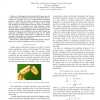Free Online Productivity Tools
i2Speak
i2Symbol
i2OCR
iTex2Img
iWeb2Print
iWeb2Shot
i2Type
iPdf2Split
iPdf2Merge
i2Bopomofo
i2Arabic
i2Style
i2Image
i2PDF
iLatex2Rtf
Sci2ools
ICRA
2006
IEEE
2006
IEEE
Model and Control of Tendon-sheath Transmission Systems
— In this paper, the tendon-sheath driving system for a robotic hand is presented and its force transmission characteristics are analyzed. The use of tendon-based transmission permits to reduce the size and the complexity of the actuation chain in many mechanical devices. A simple static model that describes the tendon-sheath driving system is presented, and its behavior is compared both with simulative results, obtained with a lumped parameters model of the tendon, and with experimental results. Different static and dynamic friction models are used in the simulations and the related results are compared to highlight some phenomena that are not visible from the static model of the tendon. A simple force control algorithm with feedforward friction compensation based on the static friction model is also presented.
| Added | 11 Jun 2010 |
| Updated | 11 Jun 2010 |
| Type | Conference |
| Year | 2006 |
| Where | ICRA |
| Authors | Gianluca Palli, Claudio Melchiorri |
Comments (0)

